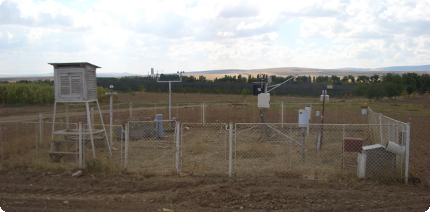Two hydro-meteorological stations, each equipped with a Kipp & Zonen CM(P) 11 pyranometer, provided data for solar radiation and the other parameters related to the characterization of the field environment each hour over several years. Average values of the parameters for long-term periods were again calculated by using these hourly measurements.
I also applied to the Turkish State Meteorological Service (TSMS) in order to get measurements from the neighbouring meteorological stations which could represent the field. Two TSMS stations had also been using CM 11 pyranometers, both in climatological and aviation applications.
In total the four measurement stations had parameters such as solar radiation (W/m2), sunshine duration (hour/day), temperature (C), wind direction (°) and speed (m/s), etc. On the other hand when I had looked back to the history of measurements from the TSMS stations, I saw solar radiation data from old mechanical actinographs in the unit of Cal/cm2/day.
There was no direct relation between W/m2 and Cal/cm2/day. I could not convert Cal/cm2/day values into W/m2 due to first one being a unit for energy and the second one a unit for power. It was a big challenge for me at that time to convert these units. I had read many articles, guides and handbooks; searched on websites, user manuals; asked some experts, etc. Nobody and nothing could solve my problem at the academic level for almost two months, until I contacted the support desk of Kipp & Zonen.
Finally I passed that hard stage thanks to my saviour, Ruud Ringoir from the Kipp & Zonen support desk. He sent me a detailed explanation on the conversion of energy units and power units. After months I successfully finished my Ph.D. study by completing the rest of the case and now I’ve been a doctor of solar energy since October 2010. I would like to thank both Kipp & Zonen and its kind expert, Ruud Ringoir.

As a result of the study I could determine the theoretical, geographical and technical solar energy potential of a farm in Haymana, a town in the Ankara Province of Turkey and also a data set for the annual hourly electricity consumption of the farm. Two operating types of photovoltaic systems, each with three different PV module structures, were simulated to match the electricity consumption of the farm.
The total sunshine duration of the field is 2607 hours/year and geographical solar energy potential of the field is 1743 kWh/m2. While the theoretical solar energy potential of the field is 2918 kWh/m2, technical solar energy potential of the field is 1891 kWh/m2/year in case of PV panels installed pointing due South and tilted at 15 degrees from vertical. HAVUÇ has 400 kW of installed power and 334 MWh/year of electricity consumption.
Performance ratios of a PV solar energy system connected to the grid with modules of single-crystalline silicon, multi-crystalline silicon and thin-film amorphous crystalline silicon are 0.85, 0.83 and 0.89 respectively. Performance ratios of an autonomous PV solar system with similar types of modules are 0.65, 0.64, 0.65 respectively. PV solar systems connected to the grid and using thin-film amorphous crystalline silicon modules are more suitable than others for the electricity consumption behaviour of an agricultural enterprise and its environmental conditions.
At the end, I’m now ready to help overcome such problems and willing to share my knowledge and experience with someone who needs it.”
Kipp & Zonen thanks Dr. Levent Yalçin of the Turkish State Meteorological Service (TSMS) for sharing with us his experiences with our pyranometers.